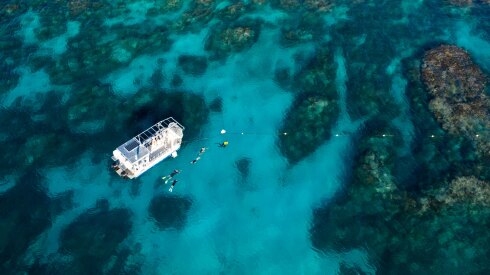The Best Hikes Near Portland
Multnomah Falls. Forest Park. Mount Hood. They’re some of the hiking world’s most beloved spots and, lucky you, they’re all within reach during your time in Portland. From day hikes to backpacking, Portland and the area beyond will keep your feet busy for miles. There are loop trails a-plenty so you never have to see the same tree twice. Prefer going up up up a mountain hike? No problem. So lace up your boots, you’ve got ground to cover.
Highlights
53000 East, Historic Columbia River Hwy, Bridal Veil, OR 97010, USA
Multnomah Falls is a gorgeous sight located about 45 minutes by car outside of Portland, Oregon, on the Columbia River Gorge. Several hikes of differing degrees of difficulty offer vantage points to view the falls. The sound of the rushing water is a soothing composition from Mother Nature.
A black, awe-inspiring lava landscape is the welcome mat to our trek into Oregon’s iconic volcano reserve. The Three Sisters: Faith/North, Hope/Middle, and Charity/South are ringed by a trail network that includes a stretch on the infamous Pacific Crest Trail (PCT). The wilderness circumnavigation of these dramatic, dormant peaks challenges hikers to keep their eyes on the trail at every bend. The big diversion on our journey is the climb to the saddle between Middle and South sisters. The area holds a short necklace of glacial lakes and challenging access through snow and ice. Great accommodations when you need to chill that cocktail at 7,500 feet. Trails up to the saddle are well defined but not maintained or officially marked, making getting lost or disoriented par for the course. The weather in August quickly goes from blazing in the lava beds to long sleeves at altitude. One night I had every bit of clothing on inside my sleeping bag to stay warm. Lower elevations produce brilliant meadows of lupine and paintbrush this time of year. Water sources are limited, but two “springs” provide gourmet liquid bubbling out of volcanic rock. This is a moderately strenuous 48-mile walk without the difficult detour to the saddle. The east-side Green Lakes trail has a restricted burn area and is less populated, while the west side PCT portion tends to be busy. Don’t let the 5,000-foot elevation gain/loss scare you off. Every step is like walking through geologic time.
4000 Southwest Fairview Boulevard, Portland, OR 97221-2706
The Hoyt Arboretum is 200 acres of local, national, and international trees. The park has a network of trails that are thematically named by the species you’ll find along the way. From the holly to the white pine, the redwood to the oak, the trails are well marked and maintained over varied terrain. When you stand at the apex of the park looking down toward the zoo, you’ll notice the remnant geography of a par-three golf course, a park feature decades ago. There is an interpretive center with a gift shop near the top of the hill, too. The trails take you to the Japanese and International Rose gardens to the east. The Oregon Zoo, Forestry Center, and Children’s Museum is to the south with the Vietnam War Memorial to the west. The Hoyt is a central point for exploring all of Washington and Forest parks. It’s part of a greenbelt that is the longest urban park in the country. With 1,400 species to explore, plan to pack a lunch. I run in the park and have no trouble getting in eight miles, but that pales compared to folks I meet out on the trail who are doing 30 miles in the woods. The Wildwood Trail is the centerpiece of the system and traverses the West Hills parks. Take the Max from downtown west to the zoo stop and see if you can find the monkey puzzle trees. You’ll have no problem wandering off and getting lost in the middle of town.
McKenzie Hwy, Blue River, OR 97413, USA
A trip up to the Dee Wright is a required trek for all my guests who visit Oregon. If you want to experience the power and beauty of the planet, the Old McKenzie Highway delivers an eyeful. Starting in Ponderosa Pine forests and climbing to 5,300 feet above sea level, the road wages a mighty battle to deliver travelers to the top. The structure at the pass is built out of lava from the surrounding flow and towers above the old wagon road that is now Route 242. The road is closed in winter, but it’s a busy corridor during the summer tourist season. The observatory has windows which become frames for the famous peaks easily seen across the barren landscape. On the top deck you can easily see Mt. Hood to the north on a clear day. An interpretive trail gives visitors a great geology lesson on Cascade volcanology. It is a very harsh environment with the blistering heat of summer and the raging snow storms of winter. One can hardly imagine moving though this moonscape in a covered, ox-drawn wagon back when Oregon was just a territory. Nothing like it.
Southwest Council Crest Drive
It’s not exactly Portland’s highest point but, at 1,073 feet, it’s close. Irrespective of how Council Crest Park measures up, it provides a view of five surrounding mountains on a clear day: Rainier, Adams, Jefferson, Hood, and St. Helens, with helpful indicators showing which mountain is which for those not as versed in freestyle mountain identification as lifelong Portlanders are. Bolder folks may opt to hike to the summit along the trails here, though driving up the hill past suffering road bicyclists is an easier option year-round. The water tower that’s now part of the park was once a feature of the Council Crest Amusement Park, torn down in 1941.














